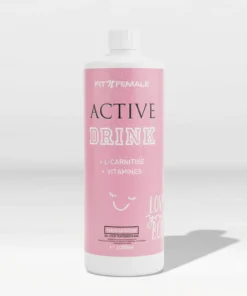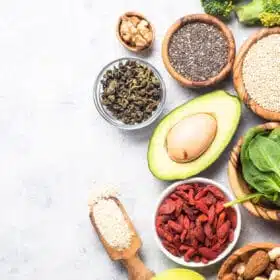In the second part of our training and nutrition guide, we will go into how your body stores fat and what causes you to have certain problem areas with particularly large numbers of fat cells.
Fat is stored primarily in the muscles and adipose tissue. What exactly does it look like in the tissue and how is the fat broken down and transported to the muscle cells, where they are then burned? Your muscle cells as well as blood flow have a crucial part in the transport as well as burning of the fat cells. Stubborn receptors, which are strongly increased in certain regions of your body (on the thighs, upper arms or buttocks), work like bouncers and let the organism access your fat reserves only under difficult conditions. It can be that you do not lose the problem zones despite intensive and consistent training. This is where targeted dietary supplements come into play. In addition, the proteins in your body play a crucial role. What problems arise from this and how this should affect your diet is explained to you here.
Alpha2 receptors: The gatekeepers of your problem zones
Your crisis areas, like most women, are found on the buttocks, thighs, and possibly the back of the arms in the triceps area. You'll have a very hard time getting rid of those pesky fat pads there. In fact, you've probably never managed it; and if you have, you don't want to get them back. This requires a healthy diet without any ifs and buts. First of all, let's take a look at why such problem areas exist in the first place. You essentially have two kinds of receptors. While your beta receptors break down fat in the course of lipolysis (see below) and are activated when you exercise or are otherwise made to burn fat, the alpha receptors come into play to protect your fat cells from being accessed, especially in the special areas of your body. These alpha receptors are the main reason why your problem areas exist. So the essential task is to block the alpha receptors in addition to activating the beta receptors.
How does fat loss work?
Fat cells are stored mainly in the muscles (intramuscular triglycerides) as well as in the adipose tissue - the body fat. These are your body's most important energy store. This is exactly where you want to start. Adipose tissue is divided into individual cells called adipocytes. These store triglycerides (glycerol molecule attached to three fatty acids). They serve as an energy source for your body and make up 95 % of adipose tissue or adipocytes. In order to use these stored triglycerides, your body must break them down. This process - called lipolysis - breaks down the three fatty acids (hereafter referred to as FFA) from the glycerol molecule of the triglycerides. After the FFA are taken out of the adipocytes, they bind to the protein albumin in the plasma of your blood. This provides the transport to the muscle cells. Your blood flow is therefore of particular importance in fat burning. You must take this into account in your diet and training. If the blood flow is slow, there could be too many fatty acids and the FFA are sent back to the fat tissue. Especially in your problem areas in your thighs or your buttocks, the blood flow is poor. Therefore, you need to increase blood flow right there to prevent this reversal of transport. Once the albumins have succeeded in transporting the FFA into your muscle cells, they are recombined there with glycerol to form triglycerides or "stapled" to the intramuscular proteins. They are then stored in the mitochondria, where they are made available for energy production. The mitochondria then burn the fat as needed. If you exercise a lot, the energy demand increases and the described process is accelerated and performed more often. There are also complementary measures that can additionally stimulate this mechanism. In summary, your problem areas are caused by poor blood circulation and the high number of alpha2 receptors that block access to the fatty acids. To get rid of the stubborn fat deposits, you need to activate lipolysis - the breakdown of triglycerides into glycerol and FFA - via the beta receptors so that the FFA can be transported through the blood into the muscle cells. Exercise is the best way to stimulate beta receptors and improve blood flow and transport of FFA. Knowing these facts, you can select supplements that can help your organism in this work.
HIIT and Low-Intensity Cardio: Burning the Stubborn Fat.
You now know that especially with exercise you can activate the beta receptors that stimulate lipolysis. That's why exercise intensity is so important. In addition, endurance training increases fat utilization and decreases carbohydrate utilization. So the best thing would be to do a long intense cardio workout, but how are you supposed to do that? You combine a High Intensity Interval Training (HIIT) of about 10-15 minutes with a subsequent cardio workout at a lower load. With HIIT, you alternate between high and low intensity intervals. For example, you might combine 100-meter sprints with casual walking. Since you can't sprint for an extended period of time because it uses the anaerobic energy systems, which you have limited access to, you need the recovery breaks. As the workout progresses, the intense intervals get weaker and weaker, but that's normal. If it's still too hard, start with slower running variations.
Here is an example of such a workout:
Do 10 to 15 reps, going full throttle for 15 seconds at a time, followed by 45 seconds of low impact. Then do 15-30 minutes of low impact cardio. The cross trainer is particularly suitable for this. Use the gym of your choice and do this workout 2-4 times a week. In addition, on the days without an intensive workout, you can do a leisurely cardio workout to accelerate fat loss. However, you should not do any workout at all at least one day a week so that your body can recover.
Targeted dietary supplement against the problem areas: Yohimbine
If despite all your efforts you are still struggling with the unwelcome fat pads, the reason in it is no longer blood circulation. You have solved this problem by doing sports. Sometimes the Alpha2 receptors prove to be very stubborn. They cannot be easily driven away. The active ingredient Yohimbine is said by various sources to be able to block the alpha2 receptors and thus open access to the body's emergency reserves. With Yohimbine, you have to watch the dose. There are stretched remedies on the internet, but they are not as intense. The most useful are the Yohimbine tablets from the pharmacy. Here in Germany you can get them only on prescription, but in the Schengen and EU country France you can buy them for little money freely in the pharmacy.
Women and proteins
Unfortunately, proteins are still undervalued among women. They rarely find the appeal in the diet in the ladies, as it should be. Supposedly, women don't need this as much as men do. This is false. Proteins consist of vital amino acids. These are essential building blocks of body tissues including muscles. However, your body cannot absorb some of the amino acids. When you exercise or do physical exertion, there are natural injuries to muscle tissue, which you may initially experience as muscle soreness. Your body is dependent on repairing these defects with new amino acids. It is similar with muscle building, because here you also need protein for the production of new muscle tissue. You need proteins at all times, so you need to get them through your diet. Without these amino acids, all the hard work of training wouldn't be worth much. They support your immune system, promote healthy connective tissue and beautiful hair and nails. In addition, they support your energy level.
The question now is how much protein you need as a woman. In general, a daily dose of 0.8 grams per kilogram of body weight is recommended for adults who sit all day. This ratio is identical for women and men. However, you as an active woman need more protein.
Background facts about proteins
The "International Society of Sports Nutrition" from the USA recently published the current status regarding protein intake. According to this, people who regularly engage in endurance training require a protein intake of 1.4 to 2.0 kg per day and body weight. With this you are not only on the safe side. You can also positively influence the success of your training. Provided you are healthy and eat a balanced and nutritious diet, this higher protein intake will not have a negative effect on your kidney functions or bone metabolism. If you exercise, your body will need more than you can get from food and drink. With supplements such as protein shakes, you can ensure the appropriate quantity and quality for your protein intake. There are different types of proteins that provide the valuable amino acids for your organism. Which proteins are the best choice for an athlete like you must be made clear to you. Above all, the timing of intake is also important, so that you can get the optimal supply. Branched-chain amino acids (BCAAs) can enhance your performance during training and your body's recovery after training. Therefore, take them shortly before and immediately after strength training. In addition, as an adult woman, you should take 2 grams per kg of body weight. For a woman with a weight of 75 kg this means an intake of 150 g of protein spread over the day if possible. With five meals, this results in 30 g of protein each time.
You can note down the following meals as examples:
1st meal: 1 boiled egg
2nd meal: One Whey protein shake with 1.5 scoops
3rd meal: about 100g chicken
4th meal (post-workout) A Whey protein shake with 1.5 scoops
5th meal: approx. 100g fish (e.g. tilapia or salmon)
There are about 30g of protein in each of these five meals.
Good sources of protein can be found in eggs, chicken, turkey, lean beef, tofu, and protein powders (especially Whey protein). You can find first-class protein in many types of fish such as salmon, halibut, tilapia or tuna. The lesser known fish in this country called "Mahi Mahi" has a very high protein content of sometimes over 35%. You see, there are good chances to get your daily protein intake. Protein shakes and BCAA tablets will help, but you can already cover a lot of it in your diet. Eat your protein diet and don't let anyone tell you that women don't need it.








